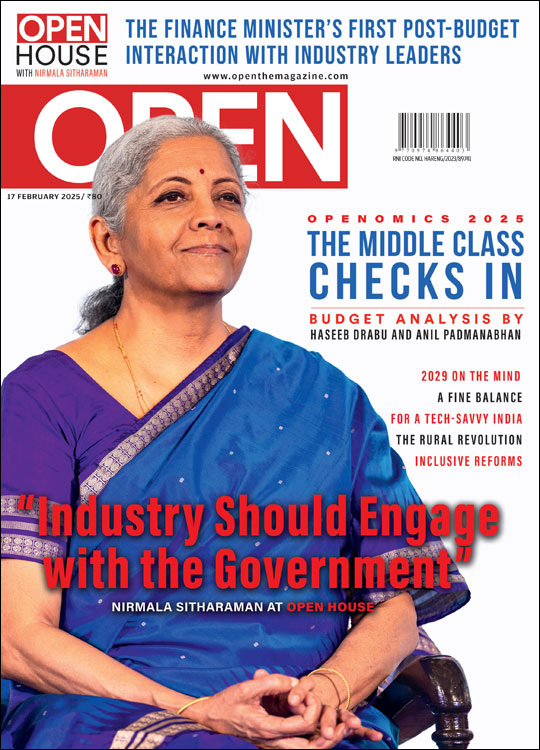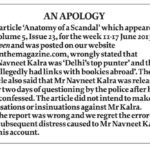Right and Radical
The understated revolution of Prime Minister Narendra Modi
/wp-content/uploads/2015/11/Rightradical-main.jpg)
The understated revolution of Prime Minister Narendra Modi
When Barack Obama completed his first 100 days in office as President of the United States of America, historian Robert Dallek reportedly said, “I don’t think you can point to anything at the end of 100 days that will give you a clear indication of how we’re going to see the President’s performance at the end of four years.” Prime Minister Narendra Damodardas Modi’s critics maintain that no signals of ‘big-ticket’ reforms, political epiphanies or landmark decisions have emerged so far from his government as it completes 100 days in office, so how can it be effectively judged?
However, in his deliberately understated, macro objective-driven governance style—this is a contrast from his highly vocal electoral quest for high office—lies the clues to Modi’s personal vision for the nation’s future over the next five years. Calculatedly toning down the 24X7 media vuvuzelas that worked to his advantage at the hustings, Modi has chosen a different style of functioning as Prime Minister. This involves precision rather than broad-sweep communication as a key tool of governance.
Says Suresh Prabhu, who was a minister in the earlier NDA Government and has now drawn up a power sector roadmap for the Modi regime to work on: “This is a government led by a leader who has extraordinary oratorical power, something that made him Prime Minister. But having become one, he believes in the adage ‘Speak less, work more’. And he leads on this from the front, working 17 hours straight every day. He has kept all [elements of the] government machinery, ministers and bureaucrats on their toes since the day he took office. He takes daily meetings not just with his ministers but also with secretaries in all key departments.” Prabhu, a seasoned Modi watcher adds, “Now, he is preparing for the next extensive performance review of his men and women in the ministerial council: the first 100 days of governance have been earmarked for planning. The next 300 are for execution of planned projects. The following four years will be for new initiatives and action and course correction, where there is need. This will be especially so in core sectors and areas, including sanitation, water, energy, jobs and the economy— and about how to optimise delivery in all these through effective governance.”
Opting for a low-key approach, among the first things Modi did as Prime Minister was set a tone of modesty for his government to follow. The bill for refurbishing the three-house complex at 7 Race Course Road was, at a mere Rs 70 lakh, less than half the sum his predecessor Manmohan Singh spent on his new residence at Motilal Marg. That he was earnest about putting an end to ostentation and clearing the capital’s power corridors of cobwebs and deadwood in order to implement his new work style and philosophy was patently clear when, one hot afternoon, close to 42 trucks of rotting files, furniture and rusting gadgetry were moved out of the Ministry of External Affairs alone.
That real winds of change had swept that key arm of the Union Government so closely connected to the PMO was apparent when bureaucrats—used to living it up—were inculcated with a new work ethos, one of shramdaan, of work as a measure of goodwill for the people. Apart from punctuality, this meant a toning down of fancy foreign terminology and greater use of regular Hindi for broad communication and a finger on the pulse of all issues related to domestic governance and foreign policy. Notes a party insider: “It was the Prime Minister’s decision to build strong new bonds with the BRICS nations and strike out boldly in new directions, and it was his decision to not indulge in a media cirque while it was being negotiated. It was also a deliberate decision to use the official media to communicate achievements. The decision to proactively communicate each step of the Government in the evacuation of Indian nurses from Iraq through the minister and ministry, minimising the prevalent and pronounced occidental jargon and attitude and mindset, was part of the same rubric.”
According to a senior official of the Ministry of External Affairs, “The decision to call off the talks [with Pakistan] despite everything was taken by the PM himself.” Explains the official, “If an accredited diplomat is asked by the host country to desist from a particular action, he should pay heed. Hurriyat leaders may have been meeting the Pakistan High Commissioner on the eve of Indo- Pak talks for more than a decade, but that is a practice that won’t be allowed any longer. Naturally, the Government sent out a strong signal to Pak: ‘either meet us or talk to marginalised separatists’.”
Politically, Modi’s signals have been just as strong. He made it amply clear to the Congress that it cannot afford the vanity of a big player after having won a mere 44 seats in the Lok Sabha. The Government first signalled that the erstwhile ruling party would have to beg for the post of Leader of the Opposition, since it had no constitutional claim, and then pushed it to seek legal refuge. Critics have called this stance churlish, pointing to the importance of a vibrant opposition in a democracy to take the Government on over its policies and programmes. But armed with the rulebook and more concerned about revitalising the economy, this is a trade-off that Modi and his men appear to have accepted.
The message to the bureaucracy from the new political head of government was straightforward and hard hitting: ‘Shape up, or else!’ There would be no more leisurely golfing during work hours, no prolonged lunches at the Gymkhana Club, and strictly no cosying up with power for plum postings. Further, making it obvious to bureaucrats across the board that they would be empowered to take informed decisions on key issues—consulting the PM directly if need be on complex matters—Modi swiftly dismantled the 62 EGoMs and GoMs set up by the UPA II. Effectively, that put a full stop to the governance machinery’s attempts to use ‘policy paralysis’, institutionalised by the Singh regime, as an excuse to delay decisions. More importantly, say observers, the move to rid the system of these groups of ministers boosted the flagging morale of bureaucrats, since their inputs would be actively sought once again for crucial decisions. In turn, this has rejuvenated multiple mechanisms of governance down the line.
Points out a Union minister, “In fact, the PM has empowered bureaucrats amply. They have also been asked to use their negotiating skills and knowledge base to the optimum, so that issues in different sectors are resolved outside the red tape and only crucial problems are entered as notations on files.” In short, he says, Modi has told bureaucrats that a red carpet welcome instead of red tape barriers should define the theme in key sectors. Backed by informed bureaucrats in a crackling new regime with well-identified objectives, ministers have been empowered to take decisions in new ways as well. Modi has directed that only projects over Rs 1,000 crore should be decided upon by the Union Cabinet. Otherwise, the concerned sector’s ministry may take the call on approvals and suchlike.
Like Obama, Modi was a commander-in-chief in the making who was raring to go and driven by the challenge of fixing a government rocked by myriad corruption scandals, a weak leadership and an economy dangerously teetering at the edge of a precipice. Once in power with an overwhelming mandate, his style and optics changed in response to perceived needs of the time. As with Obama, his assumption of power was an extraordinary moment “full of peril and full of possibilities”. Running a tight ship as a captain firmly in command and with a clear navigation map for the nation was not one among many options; it was the only way ahead.
Obama in his first term was described by one author as the ‘explainer-in-chief, advocate-in-chief and initiator-in- chief’ for his diverse political and economic agenda. When he took over, he told his council of ministers that each one’s100-day agenda was to begin from day one. Prime Minister Modi, although an ‘outsider’ to New Delhi’s political corridors, was a highly successful three- time Chief Minister of Gujarat.
“Modi exudes an energy and urgency to get things done that leaves his ministers inspired and fuelled. It is something he has carried through to the PMO from Gandhi Nagar. He believes in hitting the ground running where work is concerned and works long hours every day, all year round. That is leading by example,” says a Cabinet minister.
Even before Modi took oath, he was obsessed with fixing the Government. “Barely hours after taking office, he asked his ministers to prepare a 100-day agenda with work cut out for bureaucrats,” the minister says. That is borne out by a blog on his personal website, Narendramodi.in, which asserts that the focus for the agenda was on governance and delivery systems—the fourth revolution—rather than the optics.
The dismantling of EGoMs—once seen to assure decision making a measure of sancitity—has speeded up decisions and put vested interests and sneaky lobbyists in trouble. Among the big issues muddled by the previous government was the pricing of gas; with an EGoM involved, the decision had dragged on inordinately. To resolve it expeditiously, Modi set up a Committee of Secretaries (CoS) comprising stakeholders and relevant ministry representatives (including of the Power and Fertiliser ministries). Again, on sugarcane pricing, the old EGoM has been dispensed with and the Cabinet and Principal secretaries are now authorised to iron out problems should they arise after the Agriculture Ministry took its decision. For the resolution of complex problems in key interlinked sectors such as infrastructure, energy and power, all relevant factors are to be monitored by the National Litigation Data Grid, which is expected to speedily resolve legal hassles.
On the food inflation front, the short-term price rise of essentials is being tackled by measures spelt out in the Union Budget, while for longer term solutions to the problem, the Government has given shape to a National Food Grid to rein in agri-commodity market speculators even while pursuing a hard line at the WTO on the right to stockpile foodgrains (which buys the Centre time to switch to cash transfers as a mechanism to provide food subsidies to the eligible). The latter was done, says one bureaucrat involved with earlier WTO negotiations, “only after shunting out Congress retainers from the forum”.
Plans to amend the Land Acquisition Bill are afoot in order to give a fillip to the economy through the revival of the real-estate sector. Together with swifter industrial clearances, the easing of access to large tracts of land for big projects is expected to set off a new cycle of large investments.
That Modi is determined to revitalise the manufacturing sector in order to exponentially boost jobs and strengthen the country’s economic core has been apparent in both word and action over the past 100 days. From his ‘making India’ sound bite to his urging World Bank President Jim Yong Kim not just help the country in mass production but in production by the masses, generating jobs galore, Modi’s government has, since taking charge in May, let few opportunities go to strengthen the manufacturing sector. Within just 45 days of its taking over, Commerce Minister Nirmala Sitharaman wrote to states to switch either to a third-party system of inspection or self assessment of industry, except in the case of those involved with hazardous stuff.
Under Modi’s baton, the Government has also set itself a specific goal of easing the regulatory environment for the corporate sector in order to improve the country’s rank (it is at No 134 right now on a list of 189 nations) on a globally recognised survey of ‘Ease of Doing Business’. The areas covered, in particular, will be the Tax Department (labour, central excise, VAT), where Small and Medium Enterprises complain of being at the receiving end of the ‘hostile attitude’ of various government agencies.
“He’s a man who puts his money where his mouth is,” says a senior BJP leader, citing the instance of the manufacturing sector. Gas Authority of India Ltd (GAIL), which gets shale gas from the US, did not have sufficient ships to ferry it home—till his intervention ensured that new vessels were put at GAIL’s disposal.
As an intrinsic part of his governance style, PM Modi has made sure that most key decisions with long- and medium- term implications in core sectors are being taken steadily and firmly, if quietly. Recently, he cleared an infrastructure project pegged at Rs 250 crore in 2006 that had ballooned to Rs 1,400 crore this year. However, he appended a note that authorised an immediate probe of how the estimate had expanded so much.
How effectively Modi has managed to plug all media and government leaks on key long-term decisions, a sharp departure from the UPA’s norms, was patently clear on the disbanding of the Planning Commission. Announced by the Prime Minister in his Independence Day address, the bold decision to move away from the era of Central Planning as an economic model, by eliminating its last vestige, came as a surprise to most. It was a response to the current economic reality of India. It also signals a federalist spirit that would mean India’s states do not have to play second fiddle to the Centre on core issues. Modi’s breakthrough on this has been welcomed by everyone barring unreconstructed Nehruvian socialists.
According to Arvind Panagariya, economics professor at Columbia University, “There is need to rethink the need for institutions such as the Planning Commission … I think planning has become our habit. We should break that habit. We are in a market economy. It has to be planned but not by the Planning Commission but by the ministries. Even in China, the National Planning Commission is now called National Reforms Commission.” That body is now to take shape.
The decision was taken at a Cabinet meeting before 15 August. Insiders say that the Prime Minister sent out a categorical signal at that meeting that prematurely giving out information on the Government’s decisions to the media or anyone else would not be brooked. At that same meeting, Modi is believed to have shot a direct look at the corner of the conference table while stressing—without taking names—that he saw no need to rush to the media each time a biofuel came up at a Cabinet meeting.
Meanwhile, the rumour industry within the party and outside has painted him as an iron-fist dictator, pushing his colleagues to their limits. One such was that he called up Environment Minister Prakash Javadekar to change into traditional attire after seeing him on TV wearing a T-shirt and jeans at the Indira Gandhi International Airport just as he was about to take an overseas flight. Javadekar has denied travelling abroad recently. According to another, the Prime Minister ticked off a Union minister for being seen with a corporate chief at a five-star hotel. One particularly controversial rumour has been about an alleged case of misconduct by Pankaj Singh, son of Home Minister Rajnath Singh; the national capital was rife with gossip that Pankaj was admonished by Modi over a financial misdemeanour.
The PMO has rubbished such news reports and rumours. A statement issued by it said: ‘This has reference to reports appearing in a section of the media over the past several weeks, mentioning the Prime Minister, and referring to the conduct of some Union Ministers, and alleged misconduct of the Home Minister’s son. The reports are plain lies, motivated and constitute a malicious attempt at character assassination and tarnishing the image of the Government. Those indulging in such rumour-mongering are damaging the interest of the nation. These reports are strongly denied.’
Rajnath Singh, former party president, had been accused of pitching for his son’s candidacy from Noida for the 13 September bypoll in Uttar Pradesh. Instead, the BJP named Batham, an industrialist, as its candidate, triggering rumours that Singh’s clout within the BJP is on the wane.
This has been among the only signs of unease within the party. The Home Minister has chosen to go public with a complaint to the Prime Minister and BJP President Amit Shah on a Central Hall-generated rumour. “I had brought it to the notice of the Prime Minister and the BJP president,” Rajnath Singh told the media, and added that he was willing to quit politics if there were any allegations against him or any member of his family.
The “I believe in clean politics” assertion of the Home Minister comes in the backdrop of the PMO assuming a larger role in steering national security issues and firming up of the bureaucracy. Unlike in the past, top bureaucrats are now handpicked by the PMO and sent to the Home Ministry only for endorsement.
Singh’s outburst comes close on the heels of a generational change in the BJP. Earlier this week, Shah revamped the BJP’s Parliamentary Board after removing LK Advani and MM Joshi from the panel. “The Advani camp, which is virtually defunct now, may find a new recruit,” says a party insider.
The truth is that the proverbial camp politics is dead, and what is in its place is a new imperium of the Right presided over by India’s most popular administrator and managed by his most trusted aide. The first hundred days of Prime Minister Modi show how Right and radical it could be.

/wp-content/uploads/2025/02/Cover-Openomics.jpg)












More Columns
Haunted Spectres Urvashi Bahuguna
The Dalai Lama’s Brother Lhendup G Bhutia
Seven common myths and misconceptions about sleep debunked! Dr. Kriti Soni